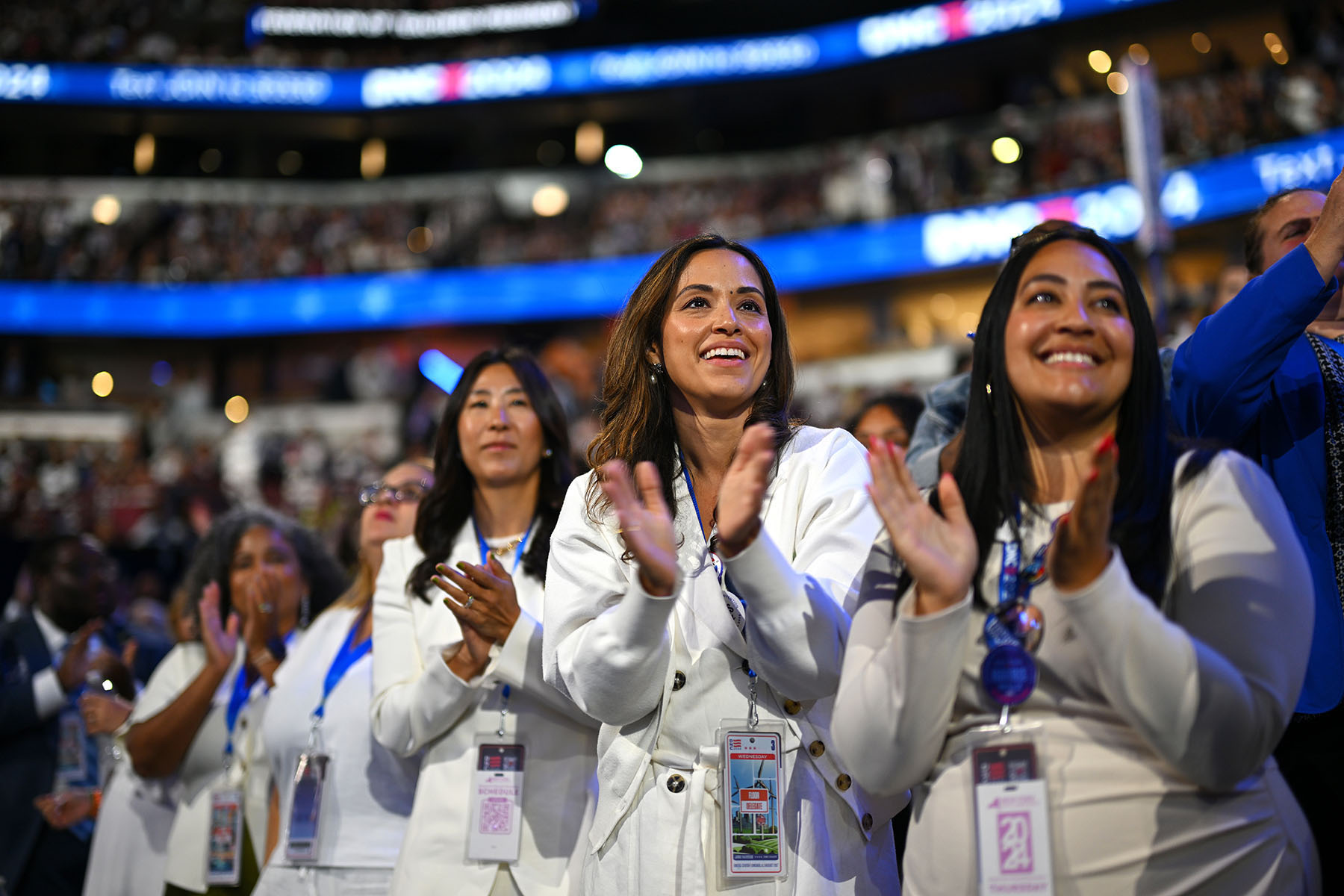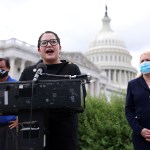Your trusted source for contextualizing Election 2024 news. Sign up for our daily newsletter.
As the presidential race entered the summer months, President Joe Biden’s level of support among Latinx voters couldn’t match the winning coalition he had built in 2020. Among Latinas, a critical group of voters who tend to back Democrats at higher levels than Latinos, lagging support had begun to worry Stephanie Valencia, who studies voting patterns among Latinx voters across the country for Equis Research, a data analytics and research firm.
Then the big shake-up happened: Biden stepped down and Vice President Kamala Harris took his place at the top of the Democratic ticket fewer than 100 days before the election.
Valencia’s team quickly jumped to action. The goal was to figure out how the move was sitting with Latinx voters in battleground states that will play an outsized role in deciding the election. After surveying more than 2,000 Latinx voters in late July and early August, Equis found a significant jump in support for the Democratic ticket, a shift that the team is referring to as “the Latino Reset.”
That reset was really pronounced among Latinas, especially those under the age of 40. I asked Valencia to dive into Equis’s survey with me and explain what it all means fewer than three months from Election Day.
This interview has been edited for length and clarity.
Mel Leonor Barclay: Can you talk about the state of the election — and the gender gap between Latinx men and women — in the first half of the year? What has changed?
Stephanie Valencia: We saw at the beginning part of this election cycle, when Biden was still at the top of the ticket, that more women were trending away from Biden than we had seen previously. And so that was a big red flag.
We saw, basically in the last month, that Harris really hit a reset button with Latinos. We were starting to see a set of trends that could have been pointing to a bigger, longer-term shift among Latinos when Biden was still the candidate. But something did reset when Kamala became the candidate. She has come out of the gate ahead of Trump and she still has a lot of work to do to define herself among Hispanic voters.
For example, she’s doing 13 points better among Latinas under 40 than Biden did. That’s the kind of swing that we saw. Overall, in our seven most competitive states, she’s sitting at 59 percent with Latinas and she’s just about 60 percent with Latinos. And again, here is where we saw a lot of attrition in the couple of months prior to the change-up — Latinas under 40 in particular. And now she’s doing 13 points better than Biden was doing.
Overall, her support among Latino women is up from 50 percent in early June. She’s now sitting at 59 percent among all Latinas. And then with Latino men, they were sitting at 41 percent under Biden and 51 percent under Harris.
With Latinas under the age of 40, what do you think is making a difference?
One of the reasons we saw the bottom fall out — and it was among women as much as it was among men in that under-40 group — was really what was happening in the Middle East, and a desire for a more swift, aggressive response for a ceasefire. And so you get to see that really creating some attrition among that age group.
I think you have seen among that group just also a reaction to the cool factor of who she is. She’s young. She’s vibrant. Her walk-on song is a Beyoncé song. It’s a very different world and I think it opened a door to have a conversation about some of those issues that are unresolved in the minds of some of those voters. They still want to see more action, more aggressiveness as it relates to trying to get to a ceasefire. But I think at the end of the day, what you are seeing is a permission structure that is now open because of who she is and the energy around who she is.
I’ve been taking a look at the campaign’s appeals to Hispanic voters and watched an ad in Spanish released by the campaign in recent weeks that leans on her story as the daughter of immigrants. Do you think that has any appeal here?
Absolutely, and it’s not the kind of tired argument we see when candidates come to Latinos and only talk to them about immigration. This is slightly different because she is the child of immigrants and she does have an immigrant story. There’s something that is kind of a wink and a nod to Latinos to say, ‘I see you. I know you.’ Obviously, not every Latino in this country is an immigrant themselves, but so many people are or have that immigrant lineage in this country, and know what it means to be a first-generation immigrant. So, that wink and a nod to say, ‘Hey, I see you. I understand you. I understand why you came to this country to pursue the American dream.’ I think that is something that we have not really had from any candidate on the Democratic side, ever.
To have a child of immigrants that is a candidate for president, really, I think, speaks to what we have seen in our research is really important to Latinos, which is the ability to achieve the American dream.
I want to dive into some states. Arizona and Nevada are the two battlegrounds with the largest share of Latinx voters. What did your August research say about the state of the presidential election in these two states? What’s the state of play for Latinas in other battlegrounds?
Six weeks ago, there seemed to be only one very narrow path into the White House, because things were slipping in Nevada and Arizona. And now, we’re seeing an expansion of the map in every part of the country.
Let’s take Arizona. In 2020, Biden got 63 percent of the vote. Right now in Arizona, Harris is sitting at 61 percent. She needs to, at a minimum, get to 63 percent among Latinos in Arizona. In Nevada, she’s sitting at 55 percent and needs to get up to 59 percent or exceed that.
Looking elsewhere, there is a huge, huge, huge role that Latinos can play because these elections, even in Wisconsin and North Carolina, Pennsylvania, are all going to be won on the margins, and that’s where Latinos can make a difference.
They’re kind of like a sleeper candidate in some of these places. Because I don’t think people quite understand how rapidly Latinos have been growing in places like Wisconsin, North Carolina, Pennsylvania and Georgia. You know, 10 percent if not, in some places, over 100 percent growth of the population over time, over the last decade. We’re seeing just rapid, rapid growth in these places and people who are engaging in the political process, many for the first time.
Given this new momentum, what do you expect to see from the Harris-Walz campaign to try to close these gaps in the final sprint to the election?
The mantra that Democrats in the Harris campaign should think about with regard to Latinos is treating Latinos with a persuasion mindset. And even though we’re seeing more and more Latinas come over to support Harris, you still have to convince them to go vote, right? These are polls, not prophecies, which means that they’re a snapshot of a moment in time and that this momentum you’re seeing right now has to be converted into real votes.
With Latinas, it’s reaffirming that she is the best candidate and it is convincing them and persuading them that they actually need to go vote, and that they have all they need to go vote, and to not be intimidated by the process or complexity of voting to stay home.
The campaign needs to go in and, you know, speak to Latinos in a way that is resonant to the issues they care about in the places they actually are. They just announced yesterday that they’re doing a WhatsApp broadcast channel — and we know the prevalence of WhatsApp in Latino communities.
These broadcast channels are used by people like Bad Bunny, and Rosalia, and the New York Times and CNN en Español. We saw Claudia Scheinbaum, the Mexican president-elect, use WhatsApp in her presidential campaign. We’ve seen candidates in Brazil and other places in the Americas, in Latin America, use WhatsApp broadcast channels as a mass communication tool.
The information landscape is changing very quickly and while people are using TikTok and Instagram, Latinos are still very much on WhatsApp as a medium to communicate with their friends and family. They have it for, you know, their soccer team that they’re on on the weekends. They have it for somebody’s quinceañera. People are using it as a tool to communicate broadly with their church group or any number of other groups that they’re a part of. It’s a very smart move by the Harris campaign.
To check your voter registration status or to get more information about registering to vote, text 19thnews to 26797.





